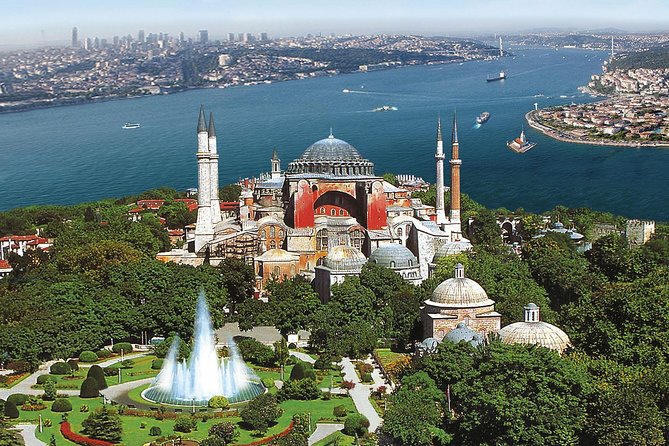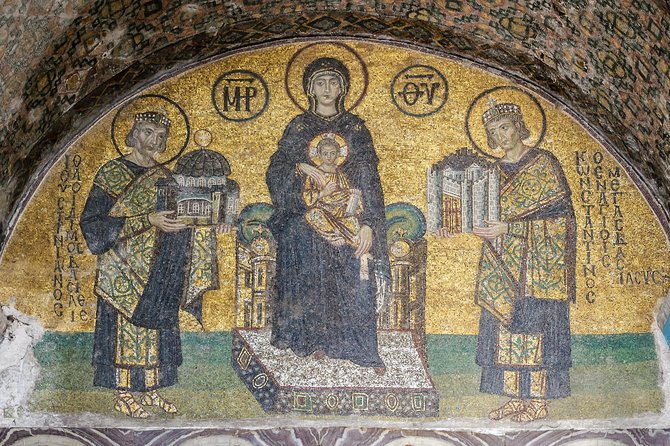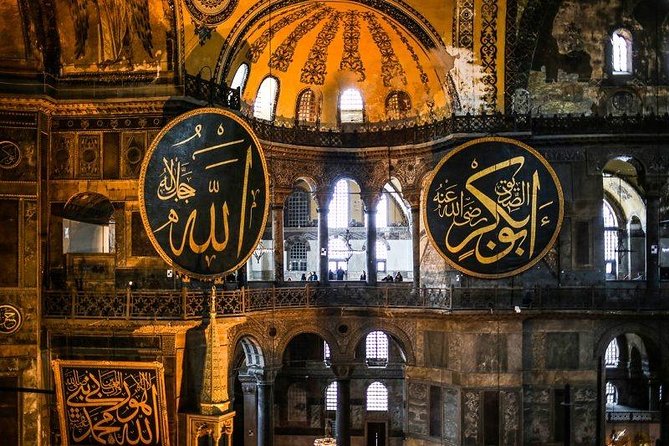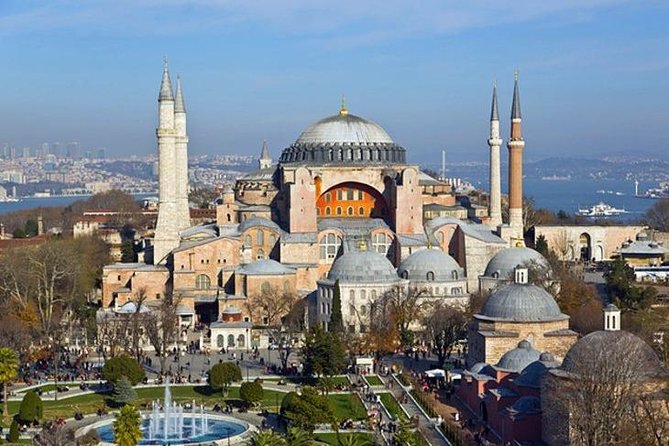Visit Istanbul Hagia Sophia – One of the Worlds Greatest Monuments
Unbeknownst to many, Istanbul’s Hagia Sophia is a marvel that has stood the test of time, bearing witness to centuries of history and evolution. Its towering dome and intricate mosaics hold secrets waiting to be unveiled by those who step through its ancient doors.
But what makes this monument truly exceptional is not just its physical grandeur; it’s the intertwining of cultures and beliefs within its walls that make it a captivating enigma. As visitors traverse through its hallowed halls, they are bound to be enveloped in a tapestry of stories and wonders waiting to be discovered.
Key Points

- Hagia Sophia’s historical transformation showcases a blend of Byzantine and Islamic architecture.
- The monument’s influence on art and culture inspires generations of artists worldwide.
- Preservation efforts highlight its significance as a symbol of intertwined histories and evolving civilizations.
- Modern global significance promotes interfaith dialogue, unity, and admiration for its timeless beauty.
Historical Significance of Hagia Sophia

The historical significance of Hagia Sophia lies in its transformation from a Byzantine cathedral to an Ottoman imperial mosque before becoming a modern-day museum. This transition encapsulates the rich tapestry of history and cultural evolution that this iconic structure has witnessed over the centuries.
Initially built as a place of Christian worship, Hagia Sophia’s conversion into a mosque under Ottoman rule added layers of Islamic architectural elements while preserving its intricate Byzantine design. The building’s walls adorned with iconic mosaics reflect a blend of religious symbolism from both Christian and Islamic traditions, showcasing a unique fusion of artistic styles.
This historical journey from cathedral to mosque to museum symbolizes the diverse cultural heritage and architectural marvels that Hagia Sophia embodies.
Architectural Marvels Inside Hagia Sophia

Inside Hagia Sophia, visitors are greeted by a breathtaking fusion of Byzantine and Islamic architectural masterpieces that intricately blend to create a captivating visual experience.
The architectural details inside Hagia Sophia showcase intricate mosaics, stunning marble pillars, and ornate calligraphy that adorn the walls and ceilings, reflecting the building’s rich history and artistic influences.
The interplay between Byzantine motifs and Islamic elements creates a unique atmosphere where visitors can admire the intricate craftsmanship and cultural amalgamation present in every corner.
The grand dome, supported by massive pillars, stands as a testament to the architectural ingenuity of the time, symbolizing the convergence of different cultures and artistic styles in this iconic monument.
Tips for Exploring Hagia Sophia Efficiently
For efficient exploration of Hagia Sophia, consider planning your visit strategically to maximize your experience and make the most of your time inside this historic monument. To enhance your visitor experience, managing time effectively is key. Utilize audio guides to learn about the monument’s rich history while navigating its halls efficiently. When capturing memories with your camera, follow these photography tips to ensure stunning shots without disrupting other visitors. Here’s a helpful table to guide you:
| Visitor Experience | Time Management |
|---|---|
| Use audio guides for detailed insights | Plan your visit to avoid crowds |
| Capture memories with photography tips | Allocate ample time for each section |
Hagia Sophia’s Influence on Art and Culture

Exploring Hagia Sophia reveals a captivating fusion of art and culture that has left an indelible mark on history, shaping the artistic landscape of the region for centuries.
The monument’s influence on art and culture is profound, with its architectural marvel inspiring generations of artists and architects. Plus, Hagia Sophia’s intricate mosaics and frescoes have served as a muse for countless painters and craftsmen, showcasing the depth of artistic influences embedded within its walls.
On top of that, the cultural impact of Hagia Sophia extends beyond its artistic allure, symbolizing the rich heritage and religious significance that have permeated through time, making it a beacon of cultural identity and unity.
Hagia Sophia’s Transformation Through History

Throughout its rich history, Hagia Sophia has undergone numerous transformations that reflect the evolving cultural and architectural influences of the eras it has witnessed. Originally built as a Christian cathedral in the 6th century, it was later converted into a mosque during the Ottoman Empire.
Hagia Sophia’s restoration progress has been ongoing, with various efforts to preserve its unique blend of Byzantine and Islamic architectural elements. The monument has also been at the center of political controversy, especially in recent times, with debates surrounding its status as a museum or mosque.
These debates highlight the deep significance and symbolic importance of Hagia Sophia, making it not just a historical site but a living testament to the intertwined histories of different civilizations.
Hagia Sophia’s Significance in Modern Times
As Hagia Sophia continues to stand at the crossroads of history and modernity, its significance in contemporary times remains a focal point of global discourse and admiration. This architectural marvel’s modern relevance lies in its ability to bridge the past and present, showcasing the enduring cultural impact it has had over the centuries. Three key aspects highlight its ongoing importance:
-
Tourism Magnet: Drawing visitors from around the world, Hagia Sophia serves as a symbol of cultural exchange and historical richness.
-
Interfaith Dialogue: Acting as a shared space for various religious communities, it promotes understanding and unity in a diverse world.
-
Architectural Inspiration: Its innovative design continues to influence contemporary architects, showcasing timeless beauty and craftsmanship.
Conservation Efforts to Preserve Hagia Sophia
Conservation experts and historical preservationists are currently implementing strategic initiatives to safeguard the architectural integrity of Hagia Sophia for future generations. The conservation efforts involve meticulous preservation techniques aimed at maintaining the structural stability and historical authenticity of this iconic monument.
Specialized teams regularly monitor the building’s condition, address any signs of deterioration promptly, and undertake necessary restoration work using traditional methods and modern technology. These preservation techniques ensure that Hagia Sophia’s unique features, such as its stunning mosaics and intricate architecture, remain intact for visitors to admire and appreciate.
Common questions
Can Visitors Bring Food and Drinks Inside Hagia Sophia?
Visitors should adhere to cultural norms and respect picnic etiquette by refraining from bringing food and drinks inside Hagia Sophia. It’s important to honor the historical significance of the monument and maintain its sanctity.
Are There Any Restrictions on Photography or Filming Inside Hagia Sophia?
Photography rules inside Hagia Sophia allow for personal use only, prohibiting commercial photography. Filming regulations require visitors to obtain permission for any filming activity. Respectful photography guidelines aim to preserve the historical and cultural significance of this iconic site.
Are There Any Guided Tours Available Inside Hagia Sophia?
Audio guides are available for self-guided tours inside Hagia Sophia. Private tours can be arranged for a more personalized experience. Visitors can enjoy the history and beauty of this iconic monument with expert guidance.
Is There Wheelchair Accessibility Inside Hagia Sophia?
Wheelchair accessibility inside Hagia Sophia includes ramps and elevators for easy navigation. Visitors with mobility needs can enjoy the historical site comfortably. The facilities cater to all guests, ensuring a seamless experience for everyone.
Are There Any Specific Dress Code Requirements for Visiting Hagia Sophia?
There are specific dress code requirements for visiting Hagia Sophia. Visitors should adhere to modest attire out of respect for cultural norms. This includes covering shoulders, knees, and avoiding revealing clothing to ensure a respectful experience.
Last Words
Discovering the wonders of Istanbul’s Hagia Sophia is a journey through time and culture, a true testament to human creativity and ingenuity.
From its historical significance to its architectural marvels, this iconic monument never fails to leave visitors in awe.
With careful conservation efforts in place, Hagia Sophia continues to stand as a beacon of art and culture, inviting travelers from around the world to experience its timeless beauty firsthand.